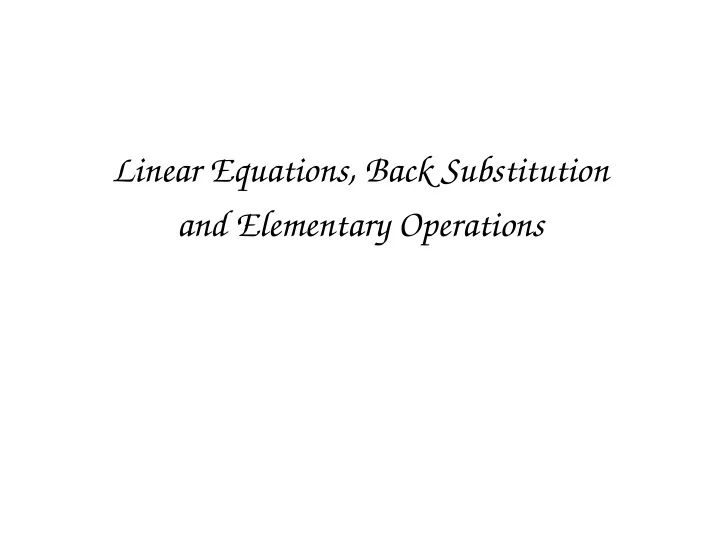

Linear Equations, Back Substitution and Elementary Operations
Systems of Linear Equations Defn. A linear equation is that the sum of coefficients times variables is some value; for example, 3 x − y = 7 . A linear system is a col- lection of linear equations. A solution of the system satisfies all Defn. the equations. A system is consistent if it has a solution. linSysONE: 2
Two Linear Equations Example: two linear equations in the two vari- ables x and y . That is, two lines in the plane. Three possibilities: (a) intersect at unique point; (b) have nothing in common; (c) are the same line Fact. There are exactly three possibilities for the solution set of a linear system: no solution, unique solution, or infinitely many solutions. linSysONE: 3
Triangular Systems Defn. A linear system is triangular if the first equation has only one variable, the second equation only two variables, and so on. linSysONE: 4
Triangular Systems Solved by Back-Substitution ALGOR Back Substitution ≻ Solve the first equation for its variable. ≻ Substitute the result into the second equa- tion, and solve for its remaining variable. ≻ Repeat. linSysONE: 5
Example Back Substitution Consider the system 2 x 1 = 6 x 1 + x 2 = 2 − x 1 + 4 x 2 + x 3 = 19 The first equation implies that x 1 = 3 . Sub- stituting this into the second equation implies x 2 = − 1 . Substituting both these values into the third equation implies x 3 = 26 . The solution is unique. linSysONE: 6
Matrices Defn. A matrix is a rectangular arrangement of numbers. Its size is the number of rows and columns. We say “ m × n matrix” to mean a matrix with m rows and n columns. linSysONE: 7
Augmented Matrix A matrix can represent a linear system. The augmented matrix is formed by adding the con- stants as the last column. For example here is a system and its augmented matrix: 2 x 1 = 6 2 0 0 6 x 1 + x 2 = 2 1 1 0 2 − x 1 + 4 x 2 + x 3 = 19 − 1 4 1 19 linSysONE: 8
Three Elementary Row Operations • Replacement : Replace row by the sum of it and a multiple of another row; e.g. replace the second row by the sum of it and 3 times the first row. Often abbreviated to “add 3 times the first row to the second” or “ R 2 ′ = R 2+3 R 1 ”. • Interchange : Interchange two rows; e.g. swap the first and third rows. • Scaling : Scale a row by nonzero factor; e.g. multiply entries in third row by 5 . linSysONE: 9
Elementary Row Operations Preserve Solution Set Why interchange? System is unchanged. Why scaling? System is unchanged. Why replacement? Solution before remains so- lution. Since process reversible, cannot have introduced new solution. Defn. Two matrices are row equivalent if can get from one to the other by elementary row op- erations. linSysONE: 10
Proofs Every Fact in this course has a proof . We some- times give the proof, sometimes sketch the high- lights, and sometimes just skip it. Mathematics rests on proof. Proof provides a guarantee that the Fact is true. Proofs use logic, calculation, previous facts, and definitions. linSysONE: 11
Summary A linear system is a collection of linear equa- tions. A solution satisfies all the equations; the system is consistent if it has a solution. A matrix is a rectangle of numbers in rows and columns. A linear system can be represented by an augmented matrix. Triangular systems can be solved by back-substitution. The three elementary row operations are replace- ment, interchange, and scaling. Each preserves the solution set. linSysONE: 12
Recommend
More recommend